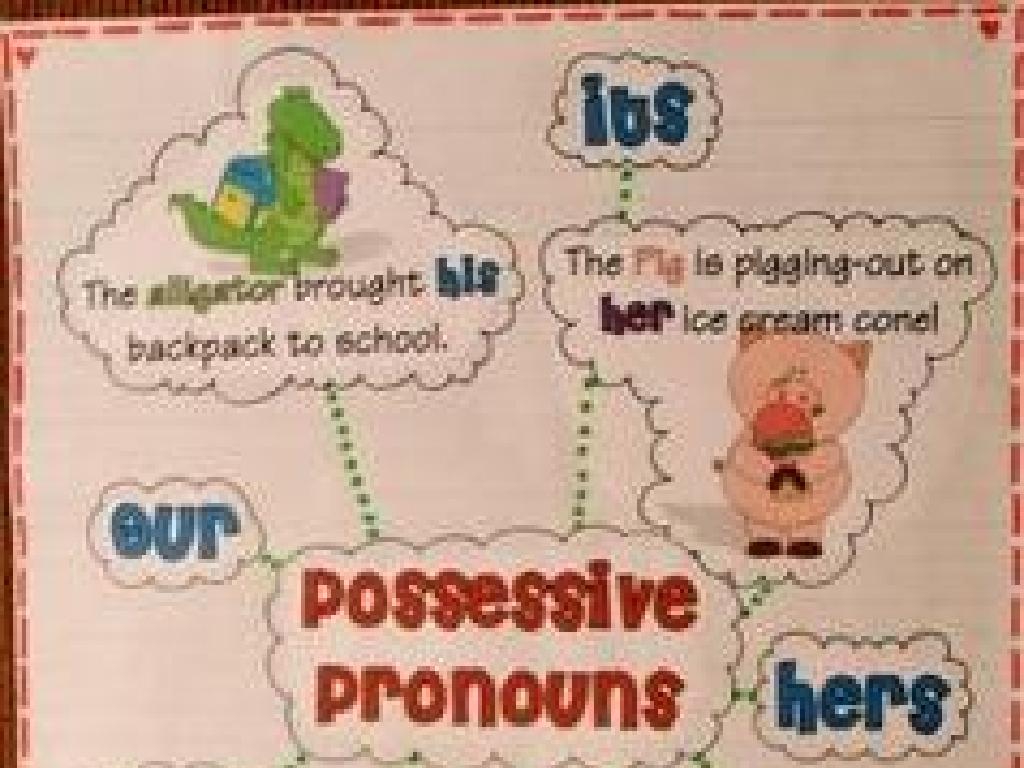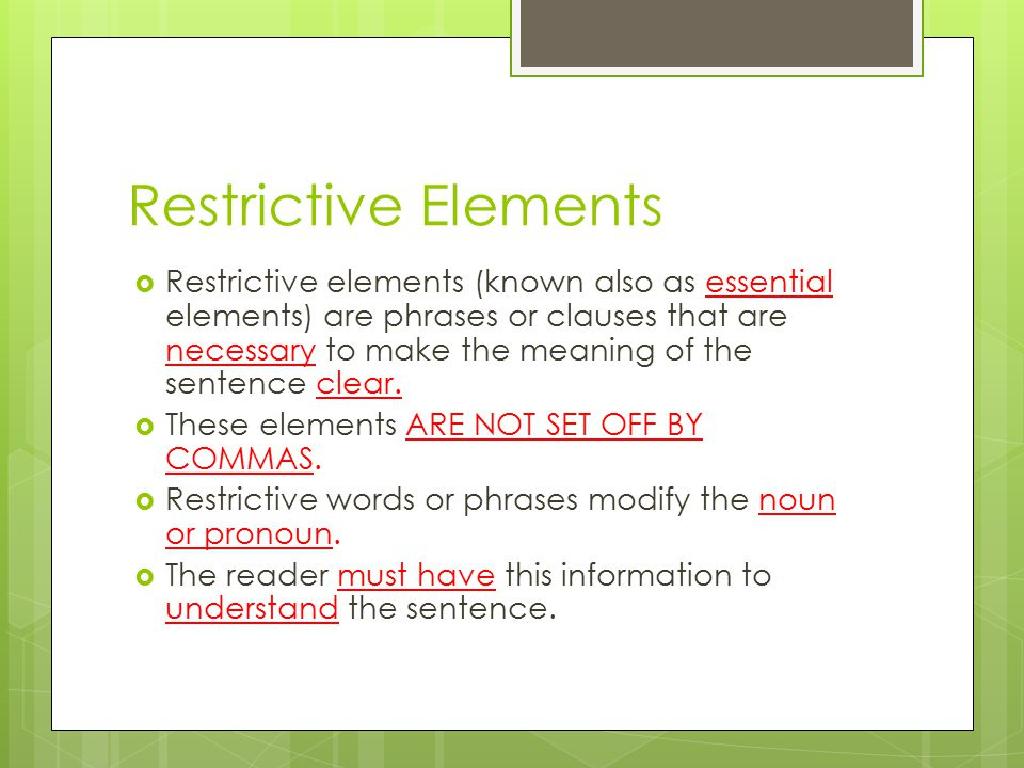Multiply Unit Fractions By Whole Numbers
Subject: Math
Grade: Fourth grade
Topic: Multiply Unit Fractions And Whole Numbers
Please LOG IN to download the presentation. Access is available to registered users only.
View More Content
Multiplying Unit Fractions by Whole Numbers
– What is a unit fraction?
– A unit fraction has a numerator of 1, like 1/3 or 1/4.
– Multiplying fractions with numbers
– To multiply, use the whole number to count how many pieces.
– Real-life unit fraction examples
– Pizza slices or a chocolate bar divided into equal parts.
– Practice problems
|
Begin the lesson by explaining that a unit fraction is a type of fraction where the top number (numerator) is 1 and the bottom number (denominator) tells us how many equal parts the whole is divided into. Demonstrate how to multiply a unit fraction by a whole number by thinking of it as adding that fraction to itself as many times as the whole number indicates. Use tangible examples like pizza slices or chocolate bars to illustrate unit fractions in real life. Conclude with practice problems to reinforce the concept, ensuring students understand how to apply the multiplication of unit fractions by whole numbers in various contexts.
Understanding Unit Fractions
– Unit fraction definition
– A fraction with 1 as its top number
– Examples of unit fractions
– Like 1/2, 1/3, 1/4, each is a unit fraction
– Unit fractions represent parts
– Each fraction is one slice of a whole pie
– Visualizing unit fractions
– Imagine cutting a pizza into equal parts
|
This slide introduces the concept of unit fractions, which are the building blocks for understanding how to multiply fractions by whole numbers. Emphasize that the numerator of a unit fraction is always 1, making it one part of a whole. Use everyday examples like slices of pizza or pieces of a chocolate bar to help students visualize and understand unit fractions. Encourage students to think of other examples of unit fractions in their daily lives. The goal is for students to become comfortable with identifying and working with unit fractions before moving on to multiplication with whole numbers.
Multiplying Whole Numbers by Unit Fractions
– Multiplication combines equal groups
– Whole number by unit fraction
– Gives us parts of a whole group
– Example: 3 x 1/4
– 3 groups of 1/4 means 1/4 + 1/4 + 1/4
– Visualize with objects or drawings
– Use items like pizza slices to show 1/4s
|
This slide introduces the concept of multiplying whole numbers by unit fractions. Start by explaining that multiplication is about combining equal-sized groups. When we multiply a whole number by a unit fraction, we are finding out how many parts of a whole we have. For example, multiplying 3 by 1/4 means we have three groups of one-fourth. Use visual aids like objects or drawings to help students understand. You can illustrate this with pizza slices, where each slice represents a quarter of the pizza, and three slices would be 3 x 1/4. Encourage students to visualize and draw these groups to better grasp the concept.
Visualizing Fraction Multiplication
– Draw to understand multiplication
– Visual example with 4 x 1/3
– Imagine having 4 pieces of a chocolate bar, each piece is 1/3
– Draw 4 groups of 1/3 each
– Sketch 4 separate sections, each representing 1/3
– Combine groups to see total
– Add the sections together to find out how much chocolate we have in total
|
This slide is aimed at helping students visualize the concept of multiplying unit fractions by whole numbers. By drawing, students can see the practical application of the multiplication process. Start with the example of 4 x 1/3, and guide the students to draw four separate groups, each representing one third. Then, instruct them to combine these groups to find the total fraction. This visual method helps solidify their understanding of how unit fractions are multiplied by whole numbers and prepares them for more abstract calculations. Encourage students to use this technique with different numbers to practice and reinforce the concept.
Multiplying Unit Fractions by Whole Numbers
– Identify the whole number and unit fraction
– Multiply whole number by the fraction’s numerator
If you have 3 x 1/4, multiply 3 (whole number) by 1 (numerator)
– Keep the denominator the same
– Write down the new fraction as your answer
Your answer for 3 x 1/4 is 3/4
|
This slide introduces the steps for multiplying unit fractions by whole numbers. Start by identifying the whole number and the unit fraction in the problem. Then, multiply the whole number by the numerator of the fraction. The denominator will remain unchanged. Finally, write down the product as your new fraction. For example, when multiplying 3 by 1/4, you multiply 3 (the whole number) by 1 (the numerator of the fraction) to get 3, and since the denominator stays the same, the answer is 3/4. Encourage students to practice with different whole numbers and unit fractions to become comfortable with this process.
Let’s Practice Together: Multiplying Fractions
– Example 1: Multiply 5 by 1/2
– 5 x 1/2 = 5/2 or 2 1/2
– Example 2: Multiply 2 by 1/3
– 2 x 1/3 = 2/3
– Step-by-step class walkthrough
– Understanding multiplication with fractions
– Multiplying a whole by a fraction gives a part of the whole
|
This slide is designed for a class activity where students will practice multiplying unit fractions by whole numbers. Start with Example 1 by demonstrating how to multiply 5 by 1/2, showing that it’s the same as finding half of 5, which equals 2 1/2 or 5/2. Then, move on to Example 2, multiplying 2 by 1/3, and explain that it’s like finding one-third of 2, which equals 2/3. Walk through the steps with the class, ensuring that each student follows along and understands the process. Emphasize that when we multiply a whole number by a fraction, we are finding a part of the whole number. For the activity, consider having students come to the board to solve similar problems, work in pairs, or use visual aids like fraction circles to help them visualize the concept.
Your Turn to Try: Multiplying Fractions
– Practice Problem 1: 3 x 1/5
Multiply 3 by the numerator 1, then keep the denominator 5.
– Practice Problem 2: 6 x 1/4
Multiply 6 by the numerator 1, then keep the denominator 4.
– Follow the multiplication steps
– Solve the problems on your own
|
This slide is an activity for students to practice multiplying unit fractions by whole numbers. Encourage them to remember the steps taught in the lesson: multiply the whole number by the numerator of the fraction and keep the denominator the same. For example, in 3 x 1/5, they multiply 3 (whole number) by 1 (numerator) to get 3, and then place it over the original denominator, 5, to get the answer 3/5. Similarly, for 6 x 1/4, they multiply 6 by 1 to get 6, and place it over 4 to get 6/4, which can be simplified to 1 2/4 or 1 1/2. Provide guidance as needed and encourage students to try solving these problems independently before reviewing the answers as a class.
Class Activity: Fraction Art
– Create art with unit fractions
– Use colored paper for fractions
– Each color represents a different unit fraction, like 1/4 or 1/3
– Record each fraction’s use
– Keep track: If you use 1/4 three times, write ‘1/4 x 3’
– Display and explain your art
|
In this engaging class activity, students will create an artwork to apply their understanding of multiplying unit fractions by whole numbers. Provide students with various colors of paper, each color representing a different unit fraction. As they create their art piece, they should keep a record of how many times they use each fraction. For example, if they use a blue paper to represent 1/4 and use it three times, they should note ‘1/4 x 3’. After completing their art, students will present their artwork to the class and explain how they used unit fractions, reinforcing their understanding of the concept. This activity caters to different learning styles and promotes creativity while solidifying mathematical concepts.
Review and Reflect: Unit Fractions & Whole Numbers
– Recap: Multiplying unit fractions
– How we multiply a whole number by a fraction like 1/4
– Real-life examples of unit fractions
– Can you think of examples like cutting a pizza into slices?
– Share your Fraction Art
– Show your art and explain the fractions used
– Reflect on what we’ve learned
|
This slide aims to consolidate the students’ understanding of multiplying unit fractions by whole numbers. Begin by reviewing the steps taken to multiply a unit fraction by a whole number, ensuring that the concept is clear. Encourage students to think of and discuss real-life situations where they might use this skill, such as dividing a pizza into equal slices or sharing equally among friends. Have students present their Fraction Art projects, explaining the fractions they used and how they multiplied them. This activity will help reinforce their understanding and allow them to see the practical application of the concept. Use this opportunity to assess comprehension and to celebrate the students’ creativity and effort.
Homework Challenge: Multiplying Fractions
– Multiply 7 by 1/6
7 groups of 1/6 make what?
– Multiply 4 by 1/8
4 groups of 1/8 make what?
– Show your work on paper
– Bring answers for review
We’ll discuss your solutions!
|
This homework challenge is designed to reinforce the concept of multiplying unit fractions by whole numbers. Students are tasked with two problems that require them to apply what they’ve learned in class. Encourage them to visualize the multiplication as repeated addition, for example, 7 x 1/6 can be seen as 1/6 added together 7 times. Remind them to write down each step of their work to show their understanding. During the review session, go over each problem, discuss different methods of solving them, and address any misconceptions. This will also be an opportunity to celebrate their efforts and correct any mistakes in a supportive environment.






